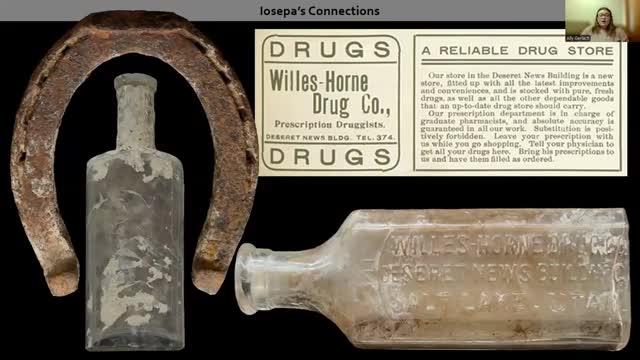Exhibit reveals hidden stories of Llosepa's vibrant past
July 26, 2024 | Utah Libraries and History, State Agencies, Organizations, Utah Executive Branch, Utah

This article was created by AI summarizing key points discussed. AI makes mistakes, so for full details and context, please refer to the video of the full meeting. Please report any errors so we can fix them. Report an error »

A recent archaeological exhibit at the Church History Museum in Salt Lake City sheds new light on the historical settlement of Llosepa, challenging long-held narratives of isolation and failure. The exhibit showcases a diverse array of artifacts that illustrate the settlement's connections to broader economic and cultural networks, both regionally and globally.
Among the notable finds are patent medicine bottles, including one from William R. Warner and Company, which highlight the unregulated market that led to the establishment of the Food and Drug Administration. The presence of items from the Willys Horn Drug Company and various products sourced from national catalogs indicates that Llosepa was not as disconnected as previously thought. Artifacts such as a 1904 Liberty head nickel and ceramic pieces from Japan further emphasize the settlement's engagement with national and international markets.
The exhibit also focuses on personal stories, featuring everyday items like buttons, jewelry, and even an ice skate, which reflect the middle-class Euro-American styles of the time. These artifacts serve to humanize the residents of Llosepa, illustrating their daily lives and cultural practices, including the blending of Hawaiian and American traditions.
Additionally, the display examines domestic life in Llosepa, showcasing artifacts associated with home life, such as dinnerware and cooking tools. The findings reveal a community that practiced self-sufficiency, with gardens and orchards contributing to their food supply, aligning with the Latter-day Saint ethos of self-reliance.
The final theme of the exhibit highlights the roles of women and children, featuring items related to personal hygiene and childcare. The narrative emphasizes the importance of midwives in the community, particularly Emily Mahoe, who not only raised twelve children but also served as a midwife, providing essential support to new mothers.
Overall, the exhibit presents a nuanced portrayal of Llosepa, countering the myth of a forgotten settlement. Instead, it reveals a vibrant community recognized for its progressiveness in the early 20th century, showcasing the resilience and interconnectedness of its residents.
Among the notable finds are patent medicine bottles, including one from William R. Warner and Company, which highlight the unregulated market that led to the establishment of the Food and Drug Administration. The presence of items from the Willys Horn Drug Company and various products sourced from national catalogs indicates that Llosepa was not as disconnected as previously thought. Artifacts such as a 1904 Liberty head nickel and ceramic pieces from Japan further emphasize the settlement's engagement with national and international markets.
The exhibit also focuses on personal stories, featuring everyday items like buttons, jewelry, and even an ice skate, which reflect the middle-class Euro-American styles of the time. These artifacts serve to humanize the residents of Llosepa, illustrating their daily lives and cultural practices, including the blending of Hawaiian and American traditions.
Additionally, the display examines domestic life in Llosepa, showcasing artifacts associated with home life, such as dinnerware and cooking tools. The findings reveal a community that practiced self-sufficiency, with gardens and orchards contributing to their food supply, aligning with the Latter-day Saint ethos of self-reliance.
The final theme of the exhibit highlights the roles of women and children, featuring items related to personal hygiene and childcare. The narrative emphasizes the importance of midwives in the community, particularly Emily Mahoe, who not only raised twelve children but also served as a midwife, providing essential support to new mothers.
Overall, the exhibit presents a nuanced portrayal of Llosepa, countering the myth of a forgotten settlement. Instead, it reveals a vibrant community recognized for its progressiveness in the early 20th century, showcasing the resilience and interconnectedness of its residents.
View full meeting
This article is based on a recent meeting—watch the full video and explore the complete transcript for deeper insights into the discussion.
View full meeting

